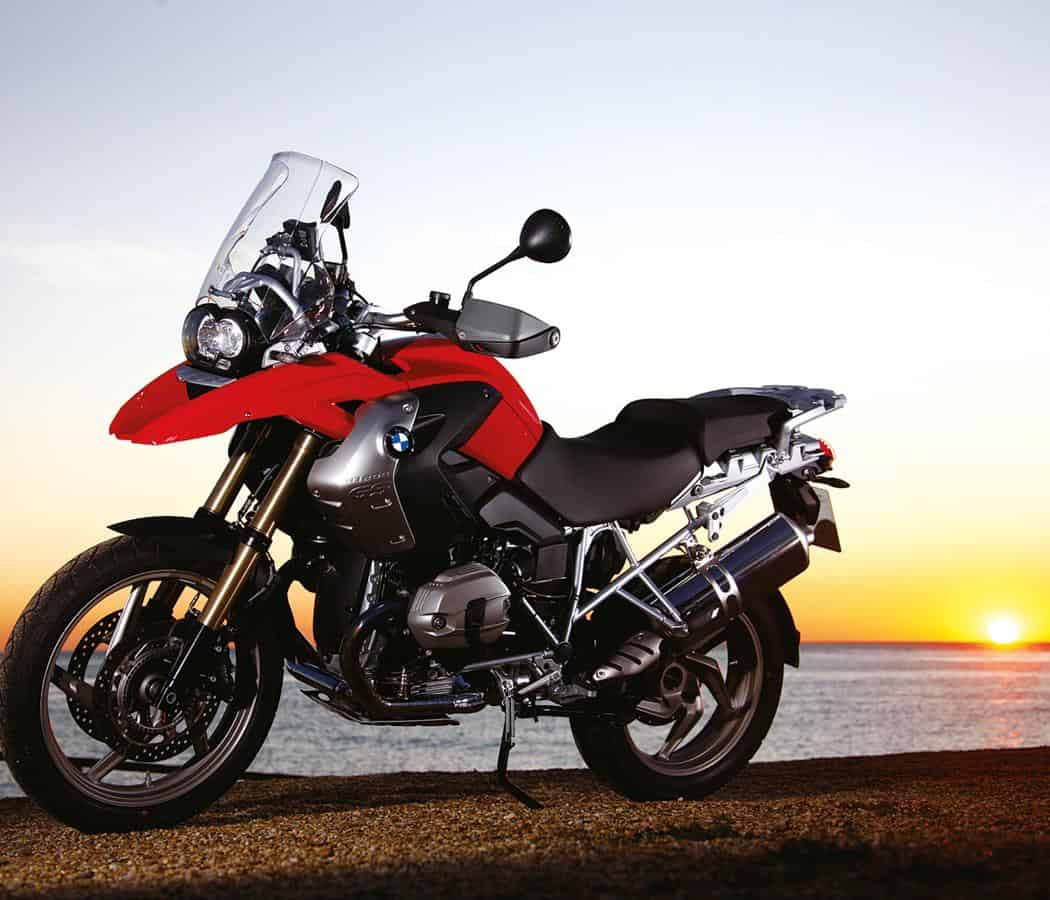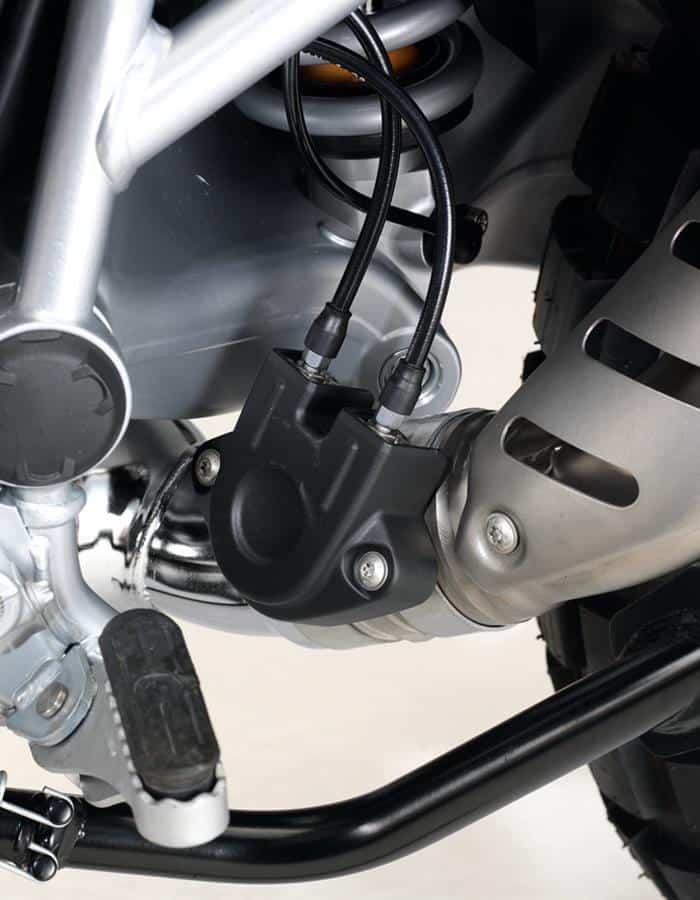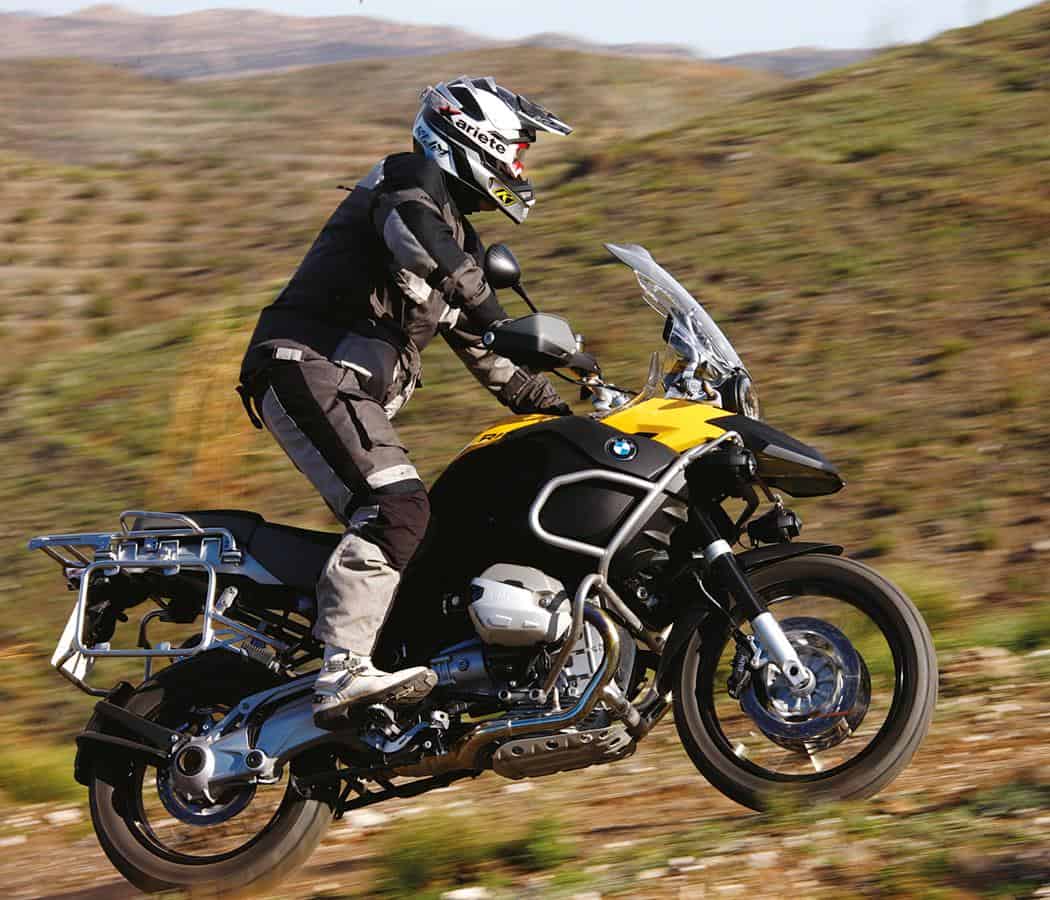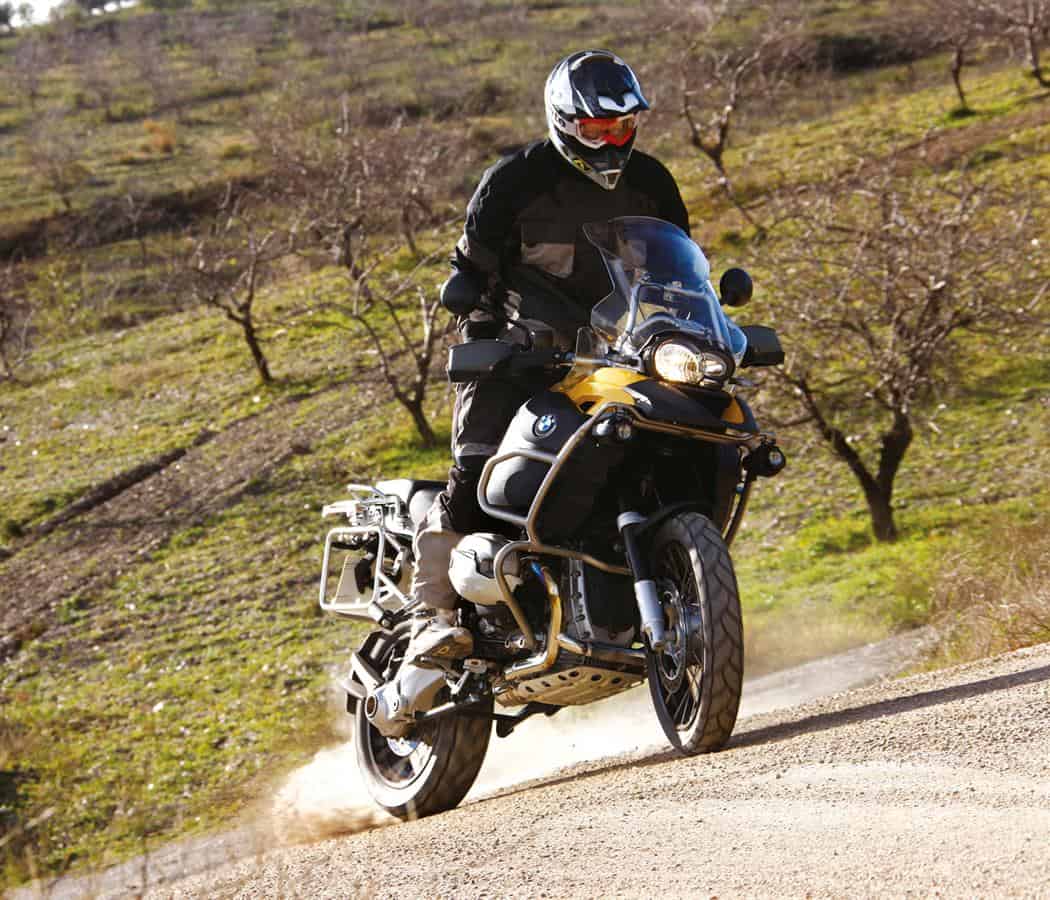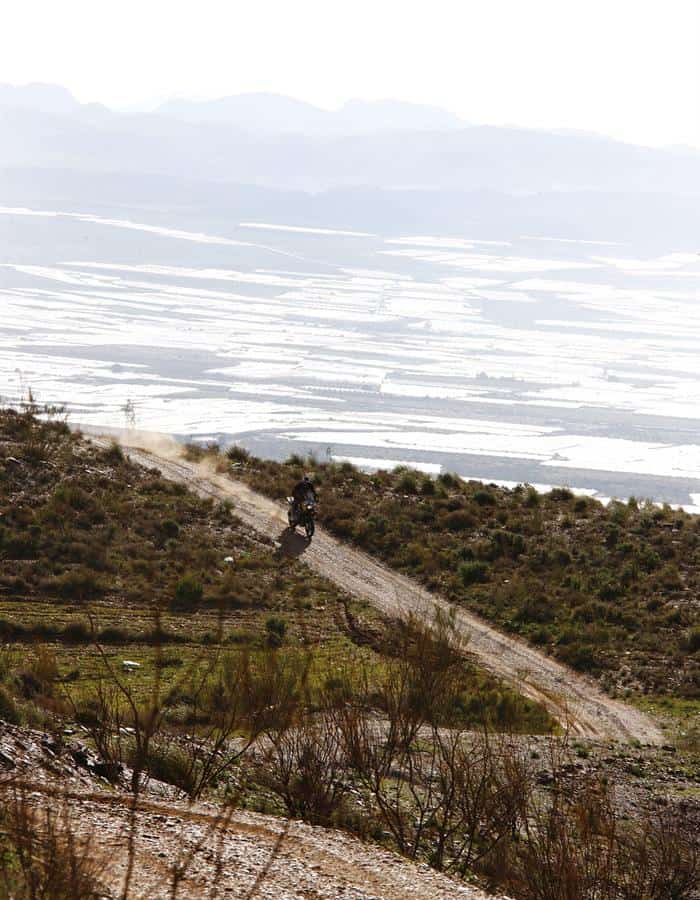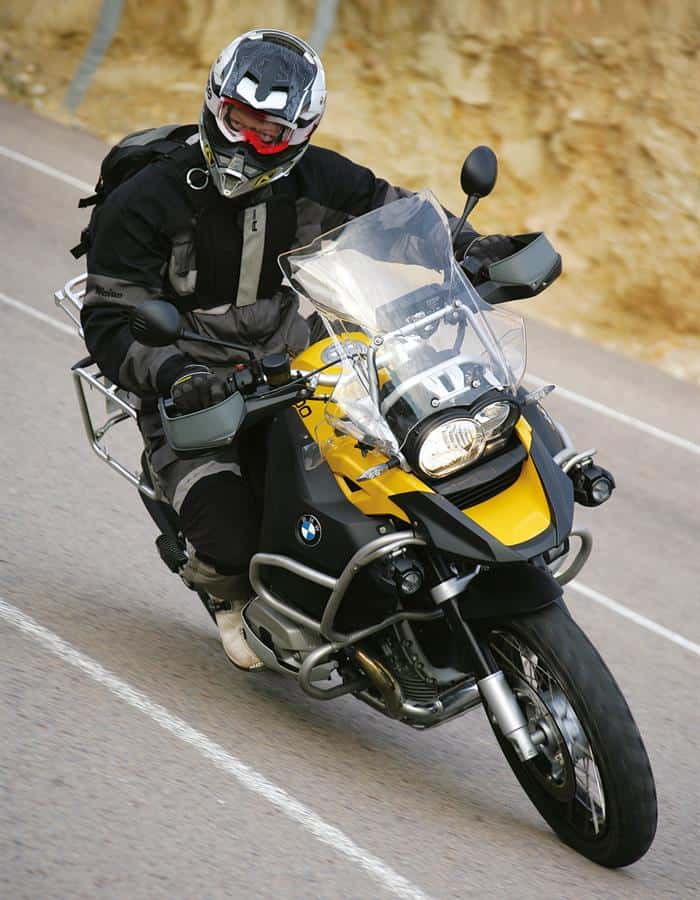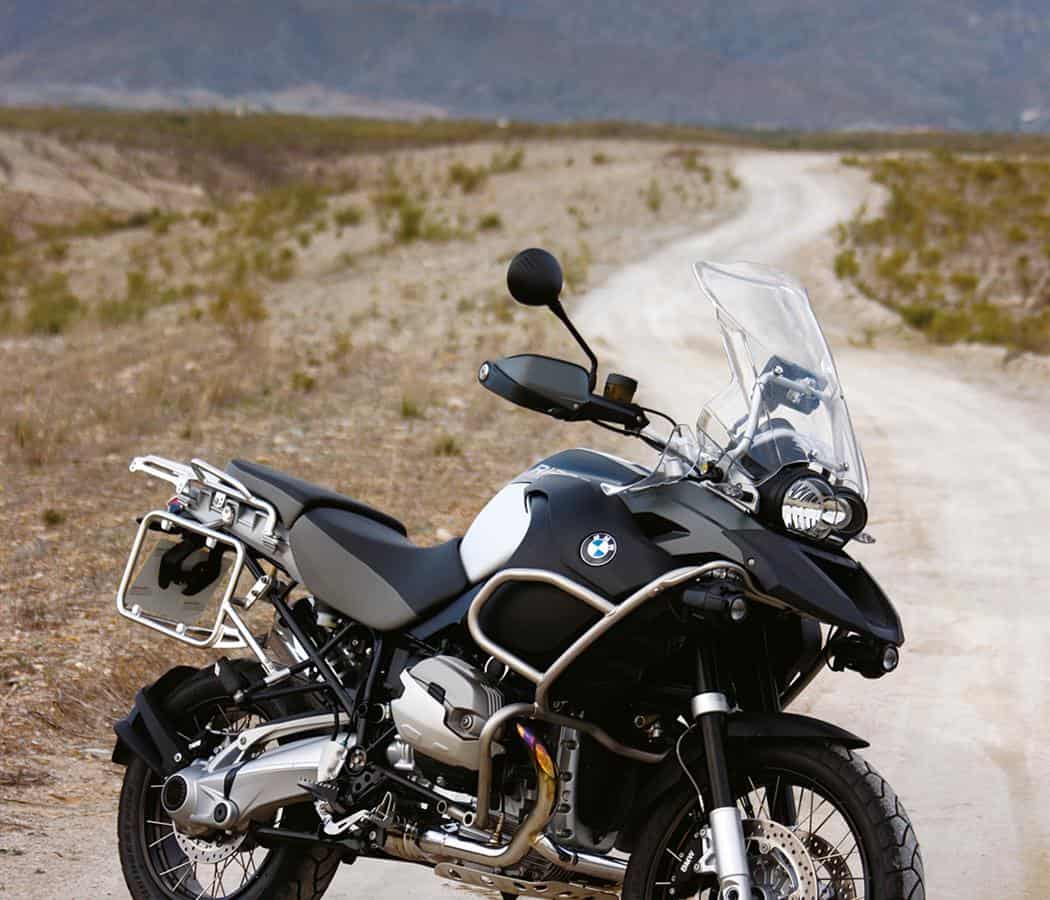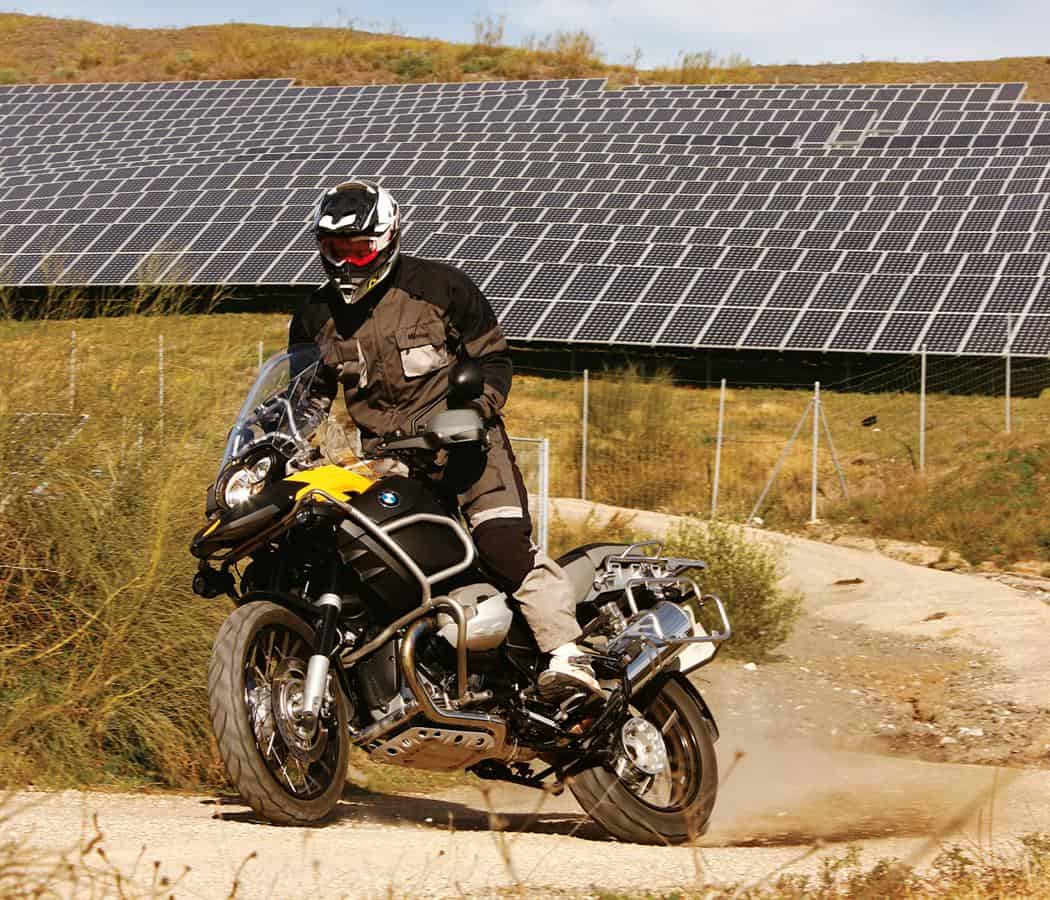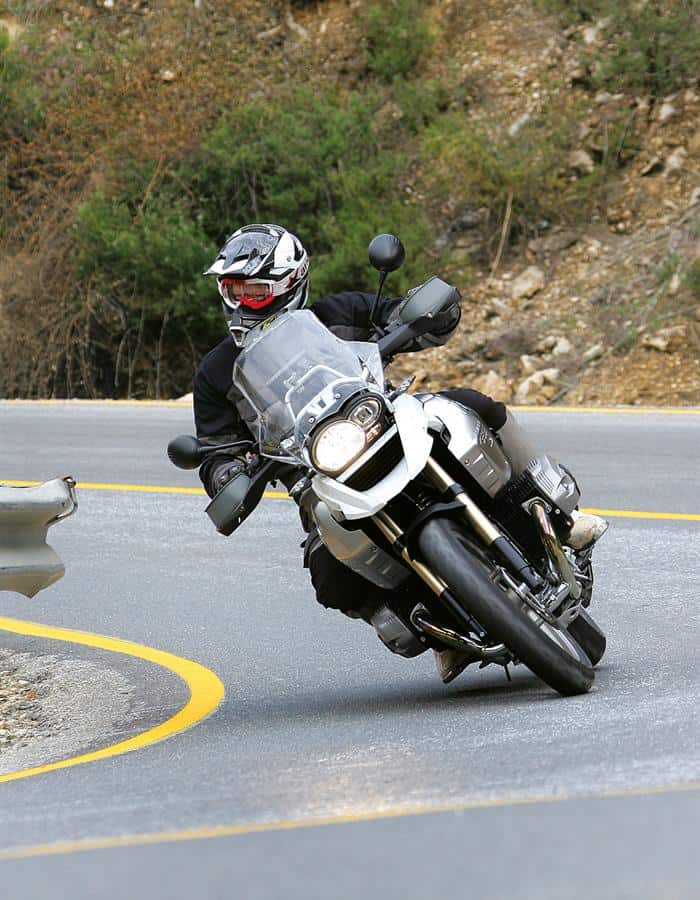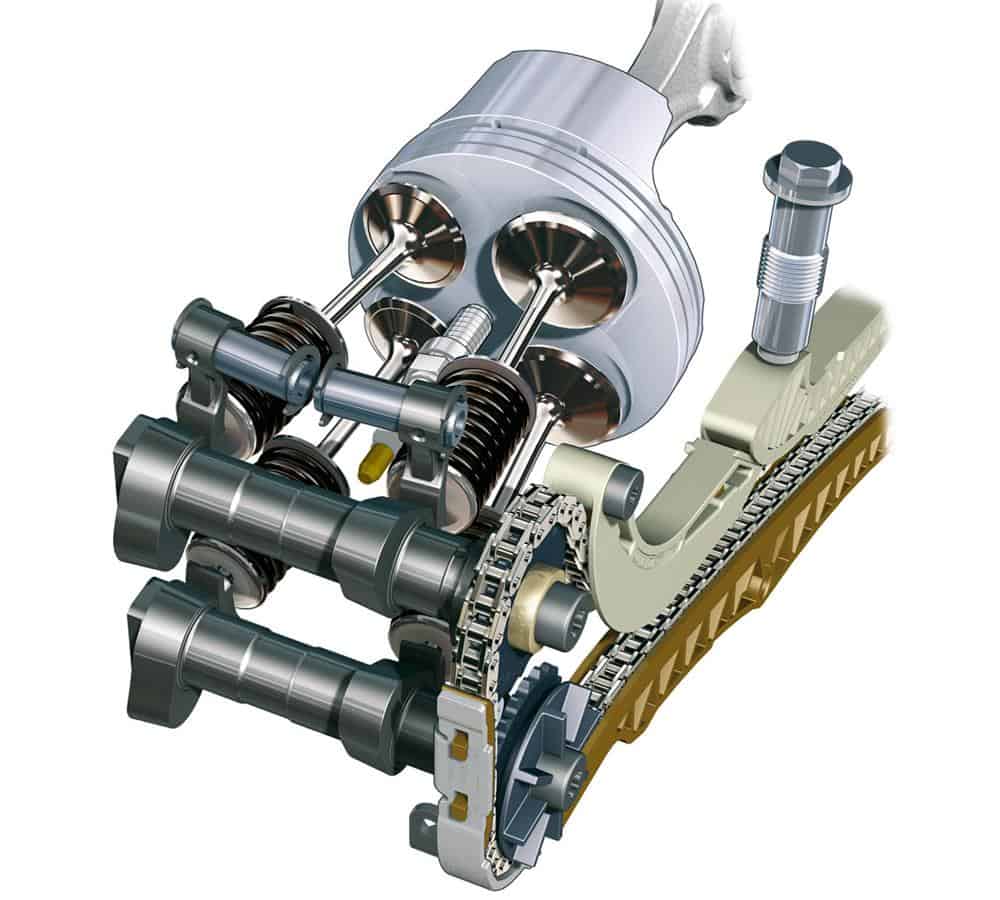It might not look much different to last year’s bike, but there’s a crucial change to the 2010 R1200GS. Barni flew to Spain to rack up some miles on the new twin-cam Beemer…
Louder, higher revving, torquier and more powerful: the kind of alterations used to lure sportsbike addicts to the latest warp speed machines not entice riders onto new adventure sport models. Yet those seven words neatly encapsulate what BMW have done to their R1200GS for 2010.
Louder – because there’s now an ‘exhaust valve’ to help boost low-end oomph and, as on certain Aston Martins, give a little extra growl to the exhaust note. Higher revving, torquier and more powerful – well that’s all down to the biggest change… the new motor.
Unless you’re particularly interested in the bike’s screen adjusters (which are now more user-friendly) or you base your bike-buying decisions primarily on colourscheme then the changes made to the new GS are, as BMW’s press officer suggested, ‘all about the engine’.
However the R1200GS itself has never really been ALL ABOUT one aspect – it’s about the complete package: the fantastic back-road handling, the versatility, the quirky looks and the go-anywhere ability. The Boxer engine IS great in this application, though it doesn’t overwhelm the riding experience. So what have BMW done exactly to update it?
What’s in the Box?
Previously the 1200GS has relied on just one cam per cylinder to help move the intake/exhaust valves. But now there’s two. Essentially the old SOHC motor has made way for the latest DOHC evolution of the air-/oil-cooled, 1170cc Boxer twin, as found in the HP2 Sport sportsbike. In that guise it produces a claimed 133bhp – about as far as the factory can take a mass production air-chilled Boxer motor, BMW’s technicians reckon – whereas in the GS it’s punting out a claimed 110bhp. Not a huge figure, but an increase over the old model of some 5bhp. The twin cam heads have also allowed a 500rpm higher rev ceiling, but arguably the most important increase on a bike of this type is in the torque. The old motor produced a claimed 84.8lb-ft while the 2010 lump shoves out some 88.5lb-ft. Nice.
High Mileage
If you’ve never been aboard a GS then on a first ride they can feel a little alien – not least that trademark Boxer torque reaction which rocks the bike to one side when you blip the throttle. The way the Telelever front-end doesn’t dip like conventional telescopic forks is another GS characteristic that can take some getting used to and likewise, of course, those infamous three-button indicators.
The seating position is a little ‘sit-up-and-beg’ and the tank stretches out (or ‘splays out’ in the case of the 33L part on the Adventure) ahead of you. It doesn’t feel particularly ‘dirtbikey’, but then I guess that adds to the surprise when you do take to the trails…
The launch hotel’s golf course looked like a fine playground for the GS – the 15th hole in particular featured a nice kicker over the bunker and a bermed edge to the green – though I suspect it might’ve been frowned upon, even though the fairways were more-or-less empty..! So it was onto the nearby motorway, for the first stage of our 400-plus mile test route.
Easing up the sliproad onto the evocatively-named ‘Autovia del Mediterraneo’, the GS picked-up beautifully off the bottom, and after short-shifting up to sixth we were soon wafting along at a reasonable pace.
Motorway miles are rarely much fun, yet at least the run along Spain’s south coast features a few sweeping esses and the glimmer of the Med just a stone’s throw away. Such long drags also give you a chance to really think about the bike beneath you. Tingling through the bars and the pegs, the bike was a little vibier than I remembered, and although they didn’t set off pins ‘n’ needles in my extremities they were certainly noticeable on the long haul. Thankfully, these smoothed out when the motor wasn’t under load, so once you’ve hit your cruising speed the GS becomes a very pleasant continent-crosser, assuming you get on with the soft seat…
With a more pronounced pillion perch the standard GS is harder to move around on once numb-bum sets in, whereas the flatter part on the Adventure allows you to find that little piece of posterior that hasn’t gone to sleep. Still, the GS remains an almost effortless mile-muncher.
Dam and Blast
A detour from the motorway led us up to an impressive dam at the head of a valley, with a twisting road clinging to the hillside high above the water’s edge.
Swapping from an Adventure onto a regular GS, the standard bike felt lighter and more precise through the wending turns. If you don’t need the capacious tank and ‘jacked-up’ suspension of the Adventure, then the stock R1200 is definitely the model to choose, for the simple reason that it’s more lithe. That’s not to say that the Adventure can’t cut it through the corners, just that it has a certain ‘gargantuan’ feel when you’re chucking it about.
The plan had been to take this fabulous road almost all of the way over to the east coast, though recent heavy rains had caused a spate of landslides in the area and we were quite likely to find our way blocked by hundreds of tons of earth, tens of tons of JCB or simply a large hole where the tarmac once sat. This was highlighted by one such earthworks mere yards from the dam, where workers were shoring-up the roadside. So it was back to the main road to eat up the miles until the next set of twisties.
The increase in low-end torque really enhances what was already a great ‘distance bike’. Stick it in sixth and just leave it there – the GS will pull from below 40mph in top without much complaint. There’s still a SLIGHT dip in the power and torque at around 5500rpm, though it’s not so serious that the GS doesn’t pull straight through it and get back into its stride.
With its new cams the GS can now rev 500rpm higher – to a redline of 8500rpm – though it’s really not the kind of bike where you go chasing every last revolution. There’s such a great spread of power available from the upper mid-range onwards that as long as the needle is in the top half of the tacho then you’ll be whistling along.
As hills clad in optically-offensive poly-tunnels gave way to row-upon-row of olive and orange trees we turned north to the roads around the small town of Sorbas. Almost perfect GS roads too – fast open corners were linked by even faster straights, whilst Jekyll and Hyde style terrain changes meant if you couldn’t see through a bend then it probably tightened up horribly into a second-gear turn or dropped down into a small ravine via a series of esses. The GS dealt with such changes in a remarkably composed manner (thanks, in part, to virtually no front-end dive), allowing you to maintain a decent pace without climbing all over the bike to get it turned. It all makes for a very unhurried ride when you’re trying to get somewhere in a hurry, if you see what I mean.
Suspended Animation
As good as the tarmac was, I was anxious to get the GS dirty (well, dusty) and it seemed rude not to when the opportunity arose! The parched ground rolled gently into a small valley, where a loose stony trail crossed the camber with an awkward turn halfway up. Thankfully, with the change to twin cams the Boxer motor seems to have lost none of its traction-eking abilities, allowing me to concentrate on avoiding the bigger rocks whilst trickling it up the climb. With the optional electronic suspension adjustment (ESA) set to its highest level the GS bounded along the faster sections of the rough trail, though bigger hits are still announced with a resounding ‘clang’ as you reach the limits of the Telelever front-end.
After a generally overcast day, the late afternoon sun ducked its head under the cloud-line and tinged the landscape a deep orange hue, signifying that it was time to head for our overnight stay.
Head for the Hills
South of Sorbas is a wonderfully sinewy road which crosses a spine of hills before dropping down into the town of Nijar. Blind hairpins abound, and accelerating out of them highlighted just how perkier the GS motor feels low down. The pick-up is instantaneous, and although the bike always felt strong at the bottom-end it now feels that bit livelier, mischievous even. Cautiously tip-toeing round the bends on the almost single-track road, as soon as you could see as far as the next bend it was time to crack the throttle… then reign it back in with the Beemer’s strong stoppers for the next tight turn.
The road climbed as we exited the village of La Rambla Honda – not sharply but deceptively – and we soon looked down over the neighbouring valley with nothing but angels to catch anyone unlucky enough to get a little giddy with the gas and sail over the edge. On the opposite side of the road the hills stretched upwards – their dark, loose, almost slate-like surface looking to offer nothing in the way of grip for an off-piste excursion. Thankfully, a series of tracks running around a farm of solar panels provided some off-road entertainment, though we were careful not to roost the CCTV-guarded cells..!
Slow corners and a covering of gravel on a rain-washed surface made for plenty of slip-sliding around, and despite the new Beemer’s more potent low-down punch it’s still particularly predictable when the back-end starts to drift.
The change to a DOHC configuration doesn’t seem to have dramatically altered the shape of motor’s power curve either, so it’s very much the Boxer we know and love. At both ends of the rev range there’s definitely more power, though not so much to completely transform the character of the engine, and the twin cams haven’t made the power delivery as abrupt as something like the 800GS. Phew!
For its size, its weight, and its power, the GS is amazingly manageable off-road. However, there’s no getting away from the fact that it IS a big bike, so when the front-end sunk into a patch of deep sand as I turned the bike around, there was a good few seconds of will-it-won’t-it as the GS teetered on the balance point between vertical and laying down on one of those new-design cylinder head covers as I struggled to haul it back upright…
Twin Peaks
Playtime over, it was back to the road for the trek back to Malaga, though this time we cut north above the majestic Sierra Nevada.
Signs warned of crosswinds, and a candy-striped windsock held horizontal at the roadside indicated a stiff breeze was blowing down through the valleys. Most of the time the GS was rock-steady, though the occasional gust was strong enough to shove it across the lane, and sudden enough that a hasty bout of counter-steering was required to bring it back under control. Thankfully the GS is stable enough at speed to allow gregarious body English without getting in a flap.
As we began to climb, so the figure on the bike’s ambient temperature display began to fall. 20, 18, 16, within maybe 20 miles it plunged ten degrees to 11.5ºc. And the terrain changed noticeably too. The barren, other worldly landscape close to the town of Tabernas where we picked up the motorway gave way to greater peaks topped with pure white icing, and a vast flatland crammed with twirling wind turbines. Then rolling hills, and multi-hued rock faces lined the roadway, before we reached the urban sprawl of Malaga, where the temperature was almost back into the 20s.
Bouncing off tunnel walls and buildings, the BMW’s new exhaust note is quite rorty when you’re onboard, yet heard from the roadside it sounds creamy smooth at full chat. Still, the decision to make an adventure bike louder is one that I have to question (after all, noise can be particularly tiring over a long journey), and the way that the valve is mounted onto the exhaust (just behind the left-hand footpeg) isn’t the subtlest piece of engineering I’ve ever seen.
Bullseye
BMW have never been ones to make swingeing changes year-on-year, and (other than a few technical gremlins) the GS hasn’t really required a large number of mods. It’s BMW’s biggest selling bike of all time (with 200,000 machines shifted since its launch in ’04), and certainly leads the ‘adventure sport’ sector in the UK market by quite some margin. So it was unlikely that they were going to suddenly change things too much. Even with bikes such as Triumph’s Tiger and the Morini Granpasso making more power, this isn’t a scene where buyers are drawn in by huge power and lairy performance, so spec sheet superiority isn’t the be-all-and-end-all – it’s rideability, usability and versatility that counts. But you have to ask ‘why not give it some more top-end?’ There’s no chance of them topping Ducati’s new Multistrada in the power stakes (and Ducati aren’t going to beat BMW in the sales stakes either!), though I can’t believe they haven’t at least matched the claimed 115bhp of the KTM Adventure R! Unless by NOT beating the opposition’s power outputs, they’re saying that the GS doesn’t actually NEED more power to be the better bike… Hmmmm.
Which leads me to question whether the latest changes are enough to make anyone currently running around on a late model GS feel that they MUST chop it in for a 2010 model. And to be honest I don’t think they are. The bike’s better for the updates, there’s no doubt about that, but I don’t know that they’re substantial enough to make people rush out and part-ex their existing Beemer.
In many ways though the R1200GS is so good that they didn’t need to make a raft of major changes, and I’m certain that the new DOHC machine will be as popular as ever. The 1200GS has always been exceptional as a do-it-all machine. Only now it’s just a little louder, higher revving, torquier and more powerful…
Thanks to: Scott Grimsdall at Jardine, Tony Jakeman, Steve Bellars and Paul Mellor at BMW UK, and ‘Evil Jim’ for all of their help.
BMW R1200GS (Adventure)
Price: £9925 OTR (£10745 OTR at the time)
Engine: Air-/oil-cooled, fuel injected, DOHC Boxer twin
Bore & stroke: 101x73mm
Displacement: 1170cc
Transmission: 6-speed, shaft drive
Frame: Two-part chro-moly trellis
Front susp: Telelever, 190mm travel (210mm)
Rear susp: Paralever, 200mm travel (220mm)
Front brake: Twin 305mm disc, four-pot calipers, ABS option
Wheelbase: 1507mm (1510mm)
Seat height: 850-870mm (910-890mm) adjustment dependant
Fuel capacity: 20L (33L)
Weight: 229kg wet, claimed (256kg)
Contact: BMW Motorrad on 0800 777 155 or www.bmw-motorrad.co.uk
GS Options Explained
BMW are masters of the options list, and virtually all of the extras you see advertised on an R1200GS are cost-options. Many of these are available in ‘packs’ which save you money over buying them separately, and extras such as ABS and heated grips are de rigeur – you’ll regret not speccing them if you come to sell the bike on. Here’s our take on just some of the GS’s many options:
ABS: BMW’s antilock brake system is one of the best we’ve tried on a big trailie, offering SOME stopping capability on the dirt. Just don’t go grabbing a huge handful and expecting it to stop you dead on a loose surface. You can switch it off – and if you venture off-road then we’d advise it – though it annoyingly comes back on when you turn the ignition off. If you’re stopping briefly and staying with the bike (to look at a map, fr’instance) then use the killswitch instead, as this retains the setting.
TPC – Tyre Pressure Control: Shows you what pressure your tyres are at via the onboard computer. Handy on the road perhaps, though if you drop the pressures for dirt use it’ll continually blink a warning at you.
ESA – Electronic Suspension Adjustment: Alter the damping settings on the fly with normal, comfort or sport modes all switchable at the touch of a button. At a standstill (with the engine running) you can also adjust the preload/ride height to suit riding two-up or give the bike extra ground clearance for heading off-road. Well worth the money…
ASC – Automatic Stability Control: Traction control. Standard mode allows virtually no wheelspin and won’t let the bike wheelie. Simply doesn’t work off-road as it cuts in way too early. Sport mode allows some spin, though for off-road use it’s best turned off. Like the ABS it resets when you turn the ignition off. Quite frankly, we’d save the money.
Enduro gearbox: Only available on the Adventure, this features a lower first gear to make the bike easier to manage off-road. Well worth having and free too!
Lowered suspension: Only available on the regular GS, this £150 option lessens the suspension (wheel) travel by 35mm and lowers the seat height by some 60mm overall (in conjunction with the free-of-charge 30mm lower seat option).
You can’t get the ESA system with this option, but if you’re short in the leg and you fancy a GS then it’s great that you’ll likely be able to get your feet on the floor…



